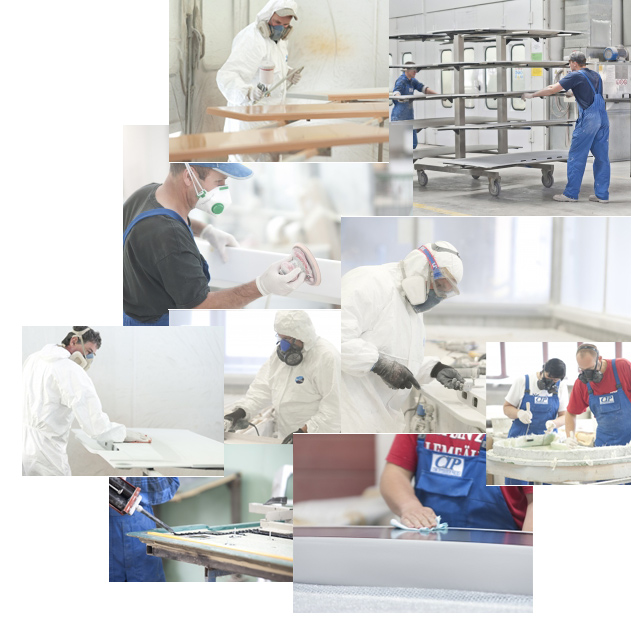
Laminates - are a type of composites : materials made from the combination of two materials with different mechanical, physical and technological properties, in which reinforcing component (so-called reinforcement) is laid in the form of layers (Latin lamina – a thin plate, the plate – hence their name – laminates), between them is a filling acting as a binder. Reinforcing layers may be in the form of continuous fibers arranged unidirectionally (called roving), fabrics or staple fiber mats. Laminate, due to its structure, is of good strength in the fiber direction, but is of very poor strength in the direction perpendicular to the layers. A typical laminate is natural wood , in which the strong and elastic, although loose , cellulose fibers are bonded to rigid and resistant material by the so-called lignen with much less mechanical durability than woodpulp.
Laminates’ characteristics:
- high mechanical durability
- high resistance to weather conditions
- high surface’s hardness
- resistance to dirt
- resistance to chemicals
- product of natural origin
Structural properties of laminates
A particular feature of the laminates is mechanical anisotropy, strength and rigidity of the laminate is directly dependent on the formation and orientation of the structural fibers. Taking into account this feature, laminate structures are generally much lighter and stronger than most structures made from homogeneous materials.
Basing on the analysis of the work of such heterogeneous materials as reinforced concrete it can be sufficiently assumed that the steel reinforcement carries only tensile forces, and concrete – compressive strength only, and in accordance with this, based on the predicted load it is possible to design optimal element from reinforced concrete. In the case of the vast majority of composite materials such simplified analysis is not possible. It is assumed that the structural fibers carry the vast majority of both compressive strength and tensile force, and binders transfer almost exclusively shear strain, ensuring cooperation of fibers as a “glue” or “connector” – its actual strength is very difficult to be determined. Consistent with these assumptions is – very important in practice – a phenomenon of significant (non-linear) decrease of durability of the laminate in both excess and deficiency of the binding substance. Difficulties in the analysis of the actual conditions of cooperation of structural fibers cause the usage (in current composites’ designs) of empirical methods rather than scientific ones. Theoretical predictions concerning composites’ durability very often are incorrect.
Glass reinforced polyester (GRP)
In industrial and amatour applications (especially boat building) dominates PS laminate. It is produced in several key technologies: the most popular is the manual application of polyester resin to arranged, inside the mold (matrix), intersecting layers of mats and glass fabric, using brushes, rollers, etc.
An improvement of this technology is the vacuum suction of air during application of resin to fabric or mat, which is very beneficial for the homogeneity of a laminate. Such saturated layer without air bubbles is applied to the previous layer in the mold. The necessary equipment and materials are not expensive or difficult to obtain, although they are unlikely to be used by amateurs and smaller plants.
Even better is the heating of the laminate during the curing of the resin, but the effective use of this technique requires the use of expensive, large-size furnaces or heaters.
Another very popular technique, however, requiring expensive equipment is spraying on non-reusable forms or ready (eg renovated) items, a mixture of resin and staple glass fiber, forming, after curing, a composite (however, such has worse mechanical properties than those based on fabrics).





 more
more